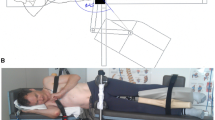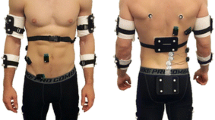Abstract
Spinal musculature plays a major role in spine stability, but its importance to spinal stiffness is poorly understood. We studied the effects of graded trunk muscle stimulation on the in vivo dynamic dorsoventral (DV) lumbar spine stiffness of 15 adolescent Merino sheep. Constant voltage supramaximal electrical stimulation was administered to the L3–L4 interspinous space of the multifidus muscles using four stimulation frequencies (2.5, 5, 10, and 20 Hz). Dynamic stiffness was quantified at rest and during muscle stimulation using a computer-controlled testing apparatus that applied variable frequency (0.46–19.7 Hz) oscillatory DV forces (13-N preload to 48-N peak) to the L3 spinous process of the prone-lying sheep. Five mechanical excitation trials were randomly performed, including four muscle stimulation trials and an unstimulated or resting trial. The secant stiffness (k y = DV force/L3 displacement, kN/m) and loss angle (phase angle, deg) were determined at 44 discrete mechanical excitation frequencies. Results indicated that the dynamic stiffness varied 3.7-fold over the range of mechanical excitation frequencies examined (minimum resting k y = 3.86 ± 0.38 N/mm at 4.0 Hz; maximum k y = 14.1 ± 9.95 N/mm at 19.7 Hz). Twenty hertz muscle stimulation resulted in a sustained supramaximal contraction that significantly (P < 0.05) increased k y up to twofold compared to rest (mechanical excitation at 3.6 Hz). Compared to rest, k y during the 20 Hz muscle stimulation was significantly increased for 34 of 44 mechanical excitation frequencies (mean increase = 55.1%, P < 0.05), but was most marked between 2.55 and 4.91 Hz (mean increase = 87.5%, P < 0.05). For lower frequency, sub-maximal muscle stimulation, there was a graded change in k y, which was significantly increased for 32/44 mechanical excitation frequencies (mean increase = 40.4%, 10 Hz stimulus), 23/44 mechanical excitation frequencies (mean increase = 10.5%, 5 Hz stimulus), and 11/44 mechanical excitation frequencies (mean increase = 4.16%, 2.5 Hz stimulus) when compared to rest. These results indicate that the dynamic mechanical behavior of the ovine spine is modulated by muscle stimulation, and suggests that muscle contraction plays an important role in stabilizing the lumbar spine.





Similar content being viewed by others
References
Chansirinukor W, Lee M, Latimer J (2001) Contribution of pelvic rotation to lumbar posteroanterior movement. Man Ther 6:242–249
Cholewicki J, Panjabi MM, Khachatryan A (1997) Stabilizing function of trunk flexor–extensor muscles around a neutral spine posture. Spine 22:2207–2212
Colloca CJ, Keller TS (2004) Active trunk extensor contributions to dynamic posteroanterior lumbar spinal stiffness. J Manipulative Physiol Ther 27:229–237
Colloca CJ, Keller TS (2001) Stiffness and neuromuscular reflex response of the human spine to posteroanterior manipulative thrusts in patients with low back pain. J Manipulative Physiol Ther 24:489–500
Colloca CJ, Keller TS, Harrison DE, Moore RJ, Gunzburg R, Harrison DD (2006) Spinal manipulation force and duration affect vertebral movement and neuromuscular responses. Clin Biomech 21:254–262
Gedalia U, Solomonow M, Zhou BH, Baratta RV, Lu Y, Harris M (1999) Biomechanics of increased exposure to lumbar injury caused by cyclic loading. Part 2. Recovery of reflexive muscular stability with rest. Spine 24:2461–2467
Goel VK, Kong W, Han JS, Weinstein JN, Gilbertson LG (1993) A combined finite element and optimization investigation of lumbar spine mechanics with and without muscles. Spine 18:1531–1541
Granata KP, Marras WS (1995) The influence of trunk muscle coactivity on dynamic spinal loads. Spine 20:913–919
Kaigle A, Ekstrom L, Holm S, Rostedt M, Hansson T (1998) In vivo dynamic stiffness of the porcine lumbar spine exposed to cyclic loading: influence of load and degeneration. J Spinal Disord 11:65–70
Keller TS, Colloca CJ (2006) Dynamic dorsoventral stiffness assessment of the ovine lumbar spine. J Biomech (in press)
Keller TS, Colloca CJ, Beliveau JG (2002) Force-deformation response of the lumbar spine: a sagittal plane model of posteroanterior manipulation and mobilization. Clin Biomech 17:185–196
Keller TS, Holm SH, Hansson TH, Spengler DM (1990) 1990 Volvo Award in experimental studies. The dependence of intervertebral disc mechanical properties on physiologic conditions. Spine 15:751–761
Kong WZ, Goel VK, Gilbertson LG, Weinstein JN (1996) Effects of muscle dysfunction on lumbar spine mechanics. A finite element study based on a two motion segments model. Spine 21:2197–2206
Latimer J, Holland M, Lee M, Adams R (1997) Plinth padding and measures of posteroanterior lumbar stiffness. J Manipulative Physiol Ther 20:315–319
Latimer J, Lee M, Adams R, Moran CM (1996) An investigation of the relationship between low back pain and lumbar posteroanterior stiffness. J Manipulative Physiol Ther 19:587–591
Latimer J, Lee M, Adams RD (1998) The effects of high and low loading forces on measured values of lumbar stiffness. J Manipulative Physiol Ther 21:157–163
Lee M, Esler M-A, Mildren J (1993) Effect of extensor muscle activation on the response to lumbar posteroanterior forces. Clin Biomech 8:115–119
Lee M, Latimer J, Maher C (1997) Normal response to large posteroanterior lumbar loads—a case study approach. J Manipulative Physiol Ther 20:369–371
Lee M, Liversidge K (1994) Posteroanterior stiffness at three locations in the lumbar spine. J Manipulative Physiol Ther 17:511–516
Lee M, Svensson NL (1993) Effect of loading frequency on response of the spine to lumbar posteroanterior forces. J Manipulative Physiol Ther 16:439–446
Lee RY, Evans JH (2000) The role of spinal tissues in resisting posteroanterior forces applied to the lumbar spine. J Manipulative Physiol Ther 23:551–556
Lee RY, Tsung BY, Tong P, Evans J (2005) Bending stiffness of the lumbar spine subjected to posteroanterior manipulative force. J Rehabil Res Dev 42:167–174
Marras WS, Granata KP (1997) The development of an EMG-assisted model to assess spine loading during whole-body free-dynamic lifting. J Electromyogr Kinesiol 7:259–268
McGill SM, Norman RW (1986) Partitioning of the L4–L5 dynamic moment into disc, ligamentous, and muscular components during lifting. Spine 11:666–678
Panjabi MM (1992) The stabilizing system of the spine. Part I. Function, dysfunction, adaptation, and enhancement. J Spinal Disord 5:383–389
Quint U, Wilke HJ, Shirazi-Adl A, Parnianpour M, Loer F, Claes LE (1998) Importance of the intersegmental trunk muscles for the stability of the lumbar spine. A biomechanical study in vitro. Spine 23:1937–1945
Shirley D, Hodges PW, Eriksson AE, Gandevia SC (2003) Spinal stiffness changes throughout the respiratory cycle. J Appl Physiol 95:1467–1475
Shirley D, Lee M, Ellis E (1999) The relationship between submaximal activity of the lumbar extensor muscles and lumbar posteroanterior stiffness. Phys Ther 79:278–285
Viby-Mogensen J (2000) Neuromuscular monitoring, pp 1352–1366
Viner A, Lee M, Adams R (1997) Posteroanterior stiffness in the lumbosacral spine. The correlation between adjacent vertebral levels. Spine 22:2724–2729
Acknowledgements
Research supported by Chiropractic Biophysics Non-profit, Inc., the Foundation for the Advancement of Chiropractic Education, and the Australian Spinal Research Foundation. Technical assistance provided by Jodie Dier, Mike Fortney, and Floyd Vilmont, and the surgical assistance by Drs. John Burke, Naffis Anjarwalla, and Yoshio Shimamura are also greatly appreciated.
Author information
Authors and Affiliations
Corresponding author
Additional information
This study was presented, in part, at the 31st Annual Meeting of the International Society for the Study of the Lumbar Spine, New York, NY, May 11–14, 2005.
Rights and permissions
About this article
Cite this article
Keller, T.S., Colloca, C.J., Harrison, D.E. et al. Muscular contributions to dynamic dorsoventral lumbar spine stiffness. Eur Spine J 16, 245–254 (2007). https://doi.org/10.1007/s00586-006-0114-z
Received:
Revised:
Accepted:
Published:
Issue Date:
DOI: https://doi.org/10.1007/s00586-006-0114-z




